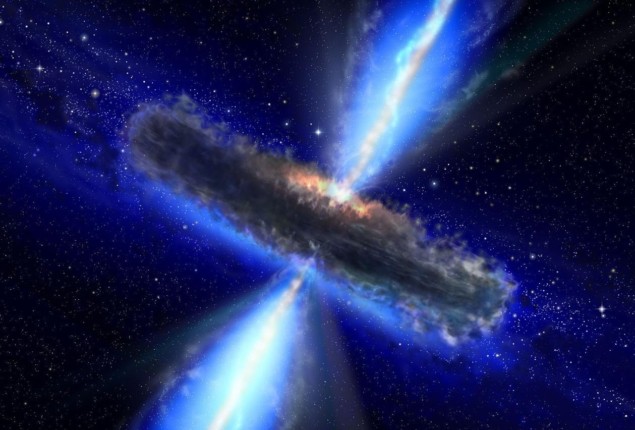
Observations of gas being sucked into the supermassive black holes at the centres of quasars have shed new light on how the astronomical objects convert gravitational energy into vast amounts of outgoing radiation. Hongyan Zhou at the Polar Research Institute of China and colleagues measured the speed of the infalling gas and confirmed that it was being supplied by “dusty tori” that surround quasars.
Quasars are so bright that they often outshine the galaxies they inhabit by several orders of magnitude. Lurking at the centre of a quasar is a supermassive black hole that can be millions or even billions of times more massive than the Sun. Vast amounts of radiation from the infrared to X-rays are emitted from a quasar and astrophysicists believe that this light is created by gas being accelerated violently in the accretion disc of matter that surrounds the black hole.
Astrophysicists are also pretty certain that quasars are sustained by a constant supply of gas that is fed into the accretion disc from a huge doughnut-shaped torus of interstellar dust that surrounds the black hole and accretion disc. However, it has proven difficult to verify this model because the vast amounts of radiation emitted by a quasar makes it very difficult to observe directly the gas as it flows from the torus to the accretion disc.
Doppler shift
To solve this problem, Zhou’s team postulated that any inflowing gas passing across our line of sight of the quasar should absorb some of the quasar’s light – and this would appear as a series of absorption lines in the quasar’s spectrum. By studying the pattern of the lines, the species of atoms responsible for the absorption can be identified. And crucially, the Doppler redshift of the wavelengths of the lines should reveal the velocity of the atoms.
The astronomers searched for two specific absorption lines — associated with hydrogen and helium – in the spectra of around 100,000 nearby quasars observed by the Sloan Digital Sky Survey. From these data, they identified eight quasars that displayed both lines simultaneously, allowing them to identify infalling gases with velocities ranging continuously from zero, to as fast as 5000 km/s.

Quasar outflows may create molecules, as well as destroying them
Furthermore, the team discovered that the outer radii of the inflows corresponded to the inner radii of the dusty tori surrounding the black holes. Overall, this implied that inflowing gas is accelerated under the pull of the central black hole, to reach freefall speed just before it reaches the accretion disk; providing a reliable source of matter for the quasar.
According to the team, their study is the first unambiguous confirmation that quasar emissions fuelled by interstellar material trapped in the sphere of influence of supermassive black holes. Now, Zhou’s team now hope to differentiate between matter in the torus and in the accretion disk. This could potentially give astronomers a better understanding of how quasars form, how long they last, and how they end.
The study is described in Nature.



